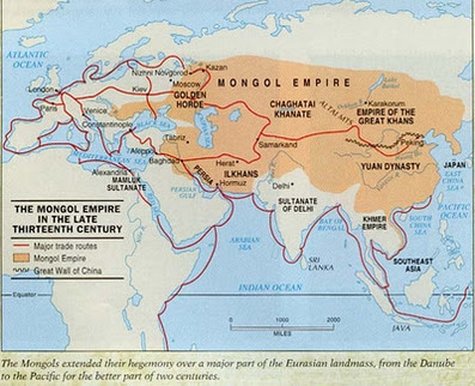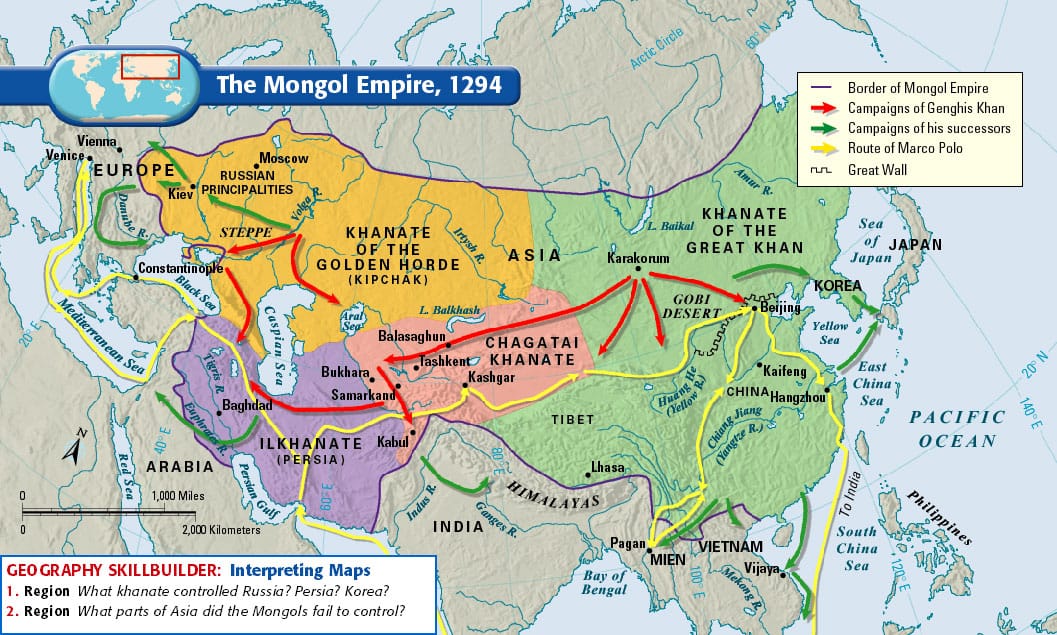|
The Big Idea: Mongol influence led to unified states in China and Korea, but the Mongol failure to conquer Japan allowed a feudal system to persist.
The Big Idea 2: Improvements in transportation, communication and technology have facilitated cultural diffusion among peoples around the world. |
Learning Targets:
|
The Mongols

An empire arose in the steppes of Mongolia in the thirteenth century that forever changed the map of the world, opened intercontinental trade, spawned new nations, changed the course of leadership in two religions, and impacted history indirectly in a myriad of other ways. At its height, the Mongol Empire was the largest contiguous empire in history, stretching from the Sea of Japan to the Carpathian Mountains. Although its impact on Eurasia during the thirteenth and fourteenth centuries was enormous, the Mongol Empire's influence on the rest of the world—particularly its legacy—should not be ignored.
Timothy May
North Georgia College and State University
http://worldhistoryconnected.press.illinois.edu/5.2/may.html
Timothy May
North Georgia College and State University
http://worldhistoryconnected.press.illinois.edu/5.2/may.html
Notes - The Mongols
Who were the Mongols? (Notes Box 1) -
View the Playposit video to fill in the sections in Box 1 of your Notes.
Slideshow - Review info you may have missed in the Playposit Video
Click on the image below to view the presentation and information. Use it to fill in your notes if you did not get the information from the video above.
Click on the image below to view the presentation and information. Use it to fill in your notes if you did not get the information from the video above.
*Now get Box 1 checked
Why did the Mongols conquer? (Notes Box 2)
Use the document below to fill in the information for Box 2.
Use the document below to fill in the information for Box 2.
| documentawhatledtotheconquests.pdf | |
| File Size: | 63 kb |
| File Type: | |
*Now get Box 2 checked!
Successes and Contributions (Notes Box 3)
Use the website below to fill in the information for Box 3.
Use the website below to fill in the information for Box 3.
Mongol Influence on China and Japan - Sources Activity 20 pts
Mongol influence on China and Japan - Sources Activity 20 pts
The Mongols gradually conquered China, and ultimately ruled the land under the leadership of Khubilai Khan, grandson of Chinggis Khan. Source 1 is a brief overview of the gradual conquest of China by the Mongols. Once they conquered, the Mongols conformed with Chinese tradition by establishing a dynasty of their own, the Yuan. Sources 2 and 3 discuss the conquests and how the political regime established by the Mongols was similar to and different from earlier Chinese dynasties. Source 4 discusses the Mongol attempts to conquer Japan.
DIRECTIONS:
1. First read the two passages of information below.
2. Next, look at the Map and take note of where China is and where Japan is. Look at the large area the Mongols were able to conquer!
3. Now you are ready to read the 4 different sources and answer questions about them.
DIRECTIONS:
1. First read the two passages of information below.
2. Next, look at the Map and take note of where China is and where Japan is. Look at the large area the Mongols were able to conquer!
3. Now you are ready to read the 4 different sources and answer questions about them.
The Mongols in China - Yuan (Mongol) dynasty (1279 - 1368
By the mid-thirteenth century, the Mongols under Genghis Khan had created a huge empire stretching from the Pacific to Europe. It included the Muslim kingdoms of Central Asia and had twice taken lands in Europe. Kublai Khan, his grandson, began as governor of an area encompassing Northern China, much of Western China and present-day Mongolia. In 1271, Kublai Khan officially declared the creation of the Yuan Dynasty, and moved the capital to Dadu (the present day capital of Beijing).
To unify China, he began a massive offensive against the Southern Song Dynasty, and finally unified the country in 1279. He ruled well, promoting economic growth. Road and water communication and transportation were reorganized and improved, and granaries were ordered built throughout the empire. The city of Beijing was rebuilt and became the final station of the Grand Canal, which was completely renovated.
While time of Mongol rule is called a dynasty, it was in fact a government of occupation. This means the Mongols occupied Chinese lands and ruled them but were not from the China themselves. The Mongols did use the existing governmental structure of the Chinese, but the language they used was Mongol, and the officials in key positions were non-Chinese from other parts of their empire - even an Italian named Marco Polo.
As the Chinese nobility were not allowed to be involved in government, they were free to pursue art and literature. This led to the development of drama, opera and the increased use of the writing.
To unify China, he began a massive offensive against the Southern Song Dynasty, and finally unified the country in 1279. He ruled well, promoting economic growth. Road and water communication and transportation were reorganized and improved, and granaries were ordered built throughout the empire. The city of Beijing was rebuilt and became the final station of the Grand Canal, which was completely renovated.
While time of Mongol rule is called a dynasty, it was in fact a government of occupation. This means the Mongols occupied Chinese lands and ruled them but were not from the China themselves. The Mongols did use the existing governmental structure of the Chinese, but the language they used was Mongol, and the officials in key positions were non-Chinese from other parts of their empire - even an Italian named Marco Polo.
As the Chinese nobility were not allowed to be involved in government, they were free to pursue art and literature. This led to the development of drama, opera and the increased use of the writing.
The Mongols and Japa
After conquering China and Korea the Mongol emperor, Kublai Khan, began an invasion of Japan. Japan at the time was ruled by the samurai who rejected Kublai's demands that they submit to Mongol domination. So Kublai built 300 ships and loaded up 15,000 men and horses to storm the island. But a storm is what the Mongols didn't plan for. But the invasion turned into a flop when a late season typhoon hit. The poorly built Mongol ships were smashed. Japan was saved. But what's even more amazing is that the Mongols tried again seven years later, this time with 3500 ships and 100,000 troops. But again, Japan got lucky. A typhoon struck again. The Japanese called the storm 'kamikazi' or divine wind.
Map of the Mongol Empire
Exit Ticket - The Mongols
Complete the Exit Ticket using your notes on the Mongols.
3 E.C. Activities
You can choose which of the below activities to do BUT if you have the time, you will end up doing all of them. These should be done on nice lined paper. If you need some then go to my tray in the back of the room to grab it! Label each activity on the lined paper so that it is clear which task you are doing. Each is worth 2 classwork points.
Activity 1
Read the website (green link) and do the task below.
The website below explains "10 Things You May Not Know About Genghis Khan." You actually may know a couple of these things since we just learned about the Mongols. Pick 5 of the things discussed about Genghis Khan and explain them to me in your own words. |
Activity 2
Read the news article (blue link) and answer the question below.
In the article it quotes the genetic researcher, Tatiana Zerjal, as saying: 'It is not the first time the oral tradition has been proved more reliable than academic treatise,' he added. 'It takes the power of genetics to prove it, however.' What does Zerjal mean by this statement (in your own words)? |
Activity 3
View the video clip and complete the activity below as you watch.
Watch the video below. As you watch, write down every case in which the Mongols are the exception. That means, every instance when something that applies to other civilizations DOES NOT apply to the Mongols! At least 3 must be found for extra credit.
Watch the video below. As you watch, write down every case in which the Mongols are the exception. That means, every instance when something that applies to other civilizations DOES NOT apply to the Mongols! At least 3 must be found for extra credit.
